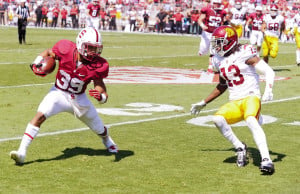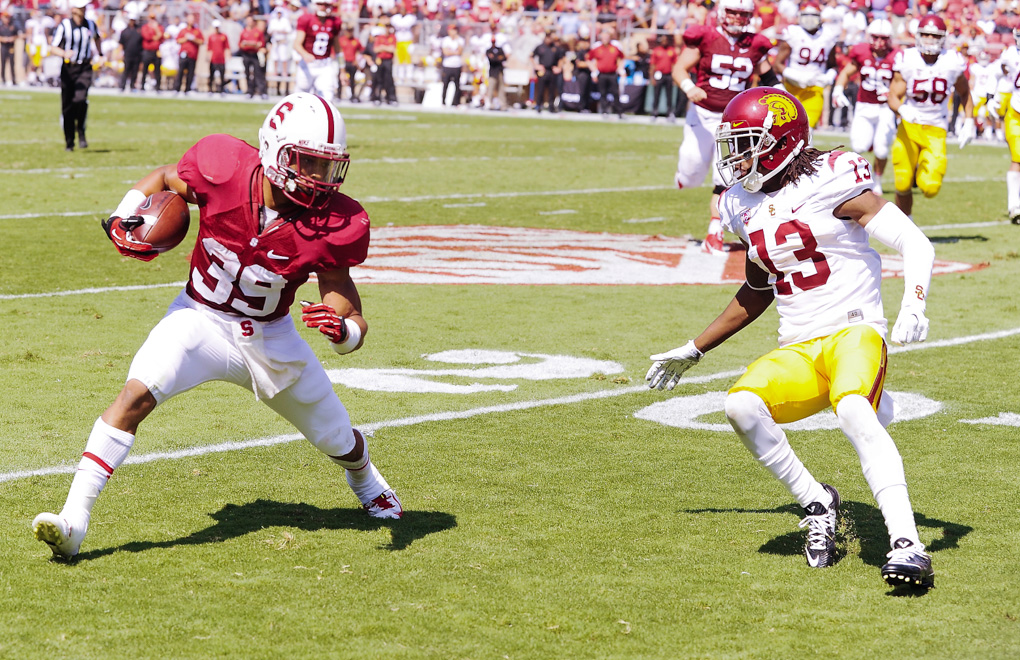
Stanford’s offense has clearly struggled to produce in its two biggest games so far this season – against USC and Washington – with blame seemingly split between the lack of a power running game, David Shaw’s play-calling, red-zone inefficiency and Kevin Hogan’s inconsistency. With Notre Dame and its traditionally dominant defense looming, we asked football writers Joseph Beyda, Jordan Wallach and Michael Peterson what the offense needs to do to take the pressure off the defense and consistently put together scoring drives.
Michael Peterson: As anti-Stanford as this idea may seem, I would love nothing more than to see Stanford attempt to air it out, Mike Leach style, against Notre Dame.
Though its passing defense is by no means a true weakness, Notre Dame has struggled a little bit against the pass this year, allowing 6.9 yards per attempt and 235.8 passing yards per game. And of course, those numbers came against teams with far inferior passing attacks than Stanford, as Notre Dame has only faced Rice, Michigan, Purdue and Syracuse.
Stanford has too many weapons in the passing game for Notre Dame to be able to effectively cover them all, and yet the Card have seemingly been unable to utilize their advantages in the passing game. Against USC, we saw Stanford use a hurry-up offense early in the game, and though it did not quite work as effectively as hoped, it was a nice change of pace and could provide a spark against Notre Dame.
Ultimately, I think this season will come down to Kevin Hogan’s performance, and that is a burden that I think Hogan may be ready to take, despite a terrible decision on the interception he threw against Washington. The power running game is absent for the foreseeable future, so why not use Ty Montgomery, Devon Cajuste, Michael Rector, Francis Owusu, Jordan Pratt and even Christian McCaffrey to light up opposing defenses through the air? For once, I would like to see Stanford call at least 60 percent passing plays.
Joseph Beyda: It is a bit misleading to say that Stanford’s offense “failed to produce” against USC and Washington. It had 413 and 364 total yards in those two games, respectively, compared to 337 yards against the Trojans and 279 against the Huskies in 2013. Up to the 35-yard line, the 2014 Cardinal offense has looked like it belongs as a top-five team.
I also disagree with Michael that Stanford’s power running game is to blame. Remound Wright and Kelsey Young totaled 187 yards on 37 carries over those two games, good for…5.05 yards per carry. (Five is your typical target in that category).
The Cardinal’s real problem is that they have failed to score points. That boils down to David Shaw’s favorite word: execution. An illegal block by Wright has killed a Stanford drive in each of those two games. The Cardinal have already lost seven fumbles through four games, approaching last year’s 14-game total of nine. And Hogan seems to have never cut down the “five bad plays a game” Shaw has been talking about since his freshman year, resulting in errant throws, poor decisions and squandered red zone opportunities.
There is nothing systemic, schematic or coachable about most of those issues. It is up to the Stanford offense to realize they are holding this team back and take some ownership.
The Cardinal’s offensive line, for example, has already done that. After a rough start to the season, the group has turned in a pair of solid performances, and held Washington (which had the most sacks in the nation coming into Saturday) to just one sack. For Stanford to have a special season, the rest of the offense has to clean up its act as well. Plain and simple.
Jordan Wallach: I completely agree with Joey that when you look at the raw numbers, Stanford’s offense is producing, and is even outperforming its opponents in terms of yardage. But ultimately, scoring points is the only way to win games and the team simply is not executing. Breaking it down further, while the Cardinal have been excelled in the first half of games, it has been right after the break when the team has had its troubles.
Stanford Offensive Splits: USC, Washington Games Combined
| Points per Quarter | Total Yards per Quarter | Passer Rating | |
| 1st Half | 5.75 | 114 | 227.45 |
| 3rd Quarter | 0 | 77 | 124.00 |
Only considering the team’s games against USC and Washington – yes, the two games in which the Cardinal offense has struggled, but really the only games against decent competition – Stanford has struggled right after halftime. The Card did not score in the third quarter in either of those games, turning the ball over three times and missing two field goals in the third frame.
One of those turnovers was an interception in the third quarter of last Saturday’s game at Washington off a ball that Kevin Hogan had no business throwing, as George Chen articulated the other day. If not for Stanford’s defense, which held the Huskies scoreless with just 120 yards on 45 plays in the second half, the game could have easily swung the other direction.
Does David Shaw need to do a better job motivating his squad at halftime? Maybe… But it comes down to Hogan and the Cardinal offense avoiding letdowns after starting these games so strongly. If not to the fans, they at least owe it to their defense.
Michael Peterson, Joseph Beyda and Jordan Wallach are trying desperately to implement Shaw’s mantra of execution, albeit to no avail, with The Daily’s flag football team ahead of November’s Ink Bowl against Cal. To give them recommendations on how to better motivate The Daily staff, please e-mail them at mrpeters ‘at’ stanford.edu, jbeyda ‘at’ stanford.edu and jwallach ‘at’ stanford.edu.
